If you’ve ever taught morphology or dabbled in Structured Word Inquiry (SWI), you’ve likely encountered the term word matrix. But what exactly is a word matrix? How can we use it to deepen students’ understanding of words? And why is it such a powerful tool for teaching spelling, meaning, and word connections? Let’s dive in.
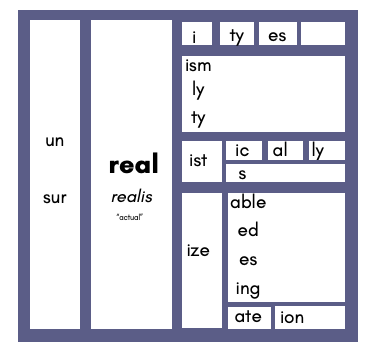
A word matrix is an incredible tool to deepen students’ understanding of words and how they work. They bring together morphology, etymology, and phonology to show the relationships between words, making vocabulary instruction more meaningful and empowering students as word detectives.
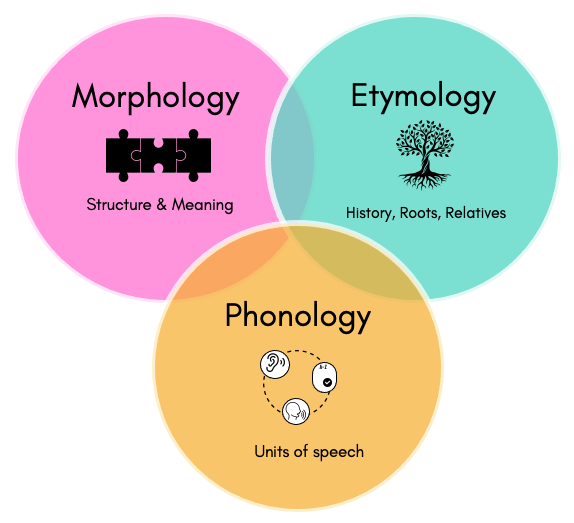
What Is a Word Matrix?
A word matrix is a visual representation of a base element and all the morphemes—prefixes, suffixes, and sometimes connecting vowels—that can combine with it to form different words. We all love graphic organizers, right? Well, this is the ultimate graphic organizer for morphology! The matrix helps students see how words are structured, providing a clear picture of the relationships between words in the same morphological family.
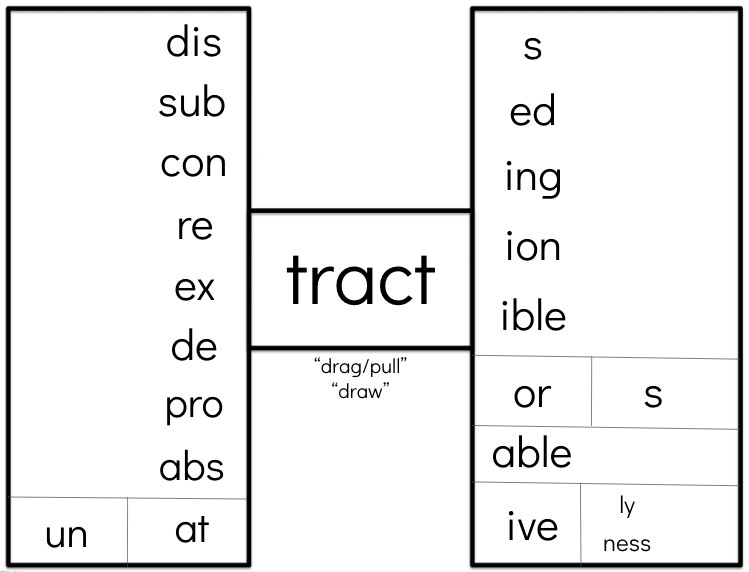
At the center of a word matrix is the base element, such as <tract>. Surrounding the base are affixes—prefixes that attach to the beginning and suffixes that attach to the end of the base.
For example, a matrix for the base <tract> might include:
- Prefixes: re-, con-, ex-
- Suffixes: -ion, -or, -ed, -ing
From this matrix, students can create words such as retract, contract, subtraction, and tractable.
Understanding Roots and Bases
To truly understand a word matrix, it’s helpful to know the difference between roots and bases. A root is the historical origin of a word, often from Latin, Greek, or other older languages, while the base is the part of the word that exists in modern English. Roots give us the sense and meaning behind a base word, and that meaning carries through to modern words—sometimes clearly and literally, sometimes in less obvious ways.
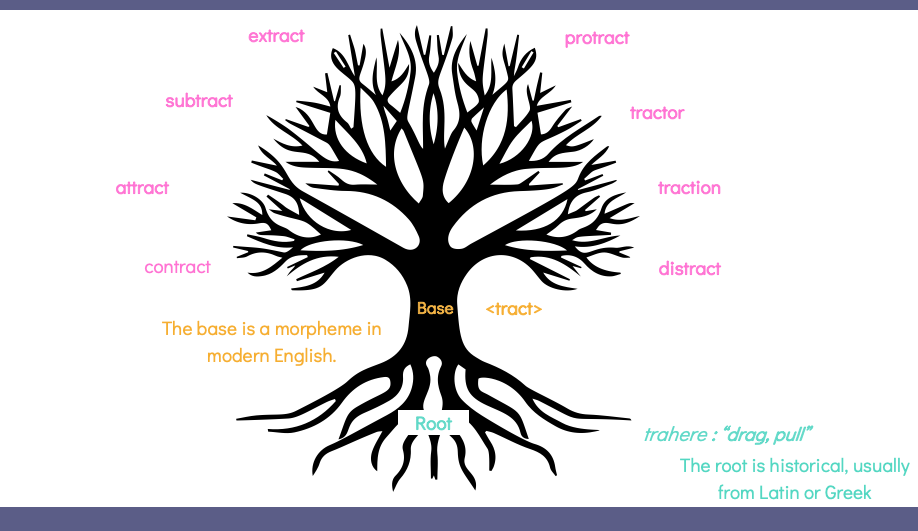
For example, the Latin root <tract> means “to pull” or “drag.” Its meaning is still clear in many English words today, such as “tractor” (a machine that pulls things) or “traction” (the pulling force that prevents slipping). In other cases, the connection is more abstract, like in “contract” (to pull together) or “distract” (to pull attention away).
How to Read a Word Matrix
Reading a word matrix involves combining the base element with prefixes and/or suffixes to form complete words.
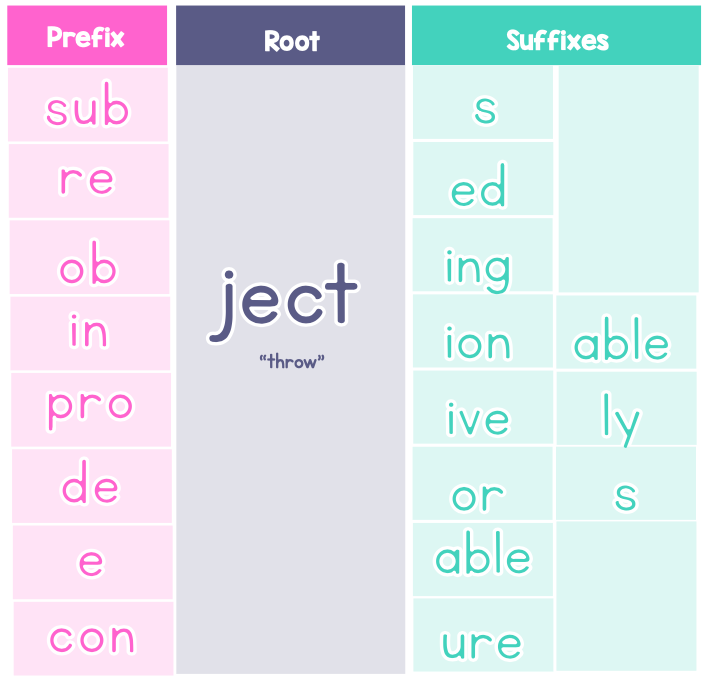
- Read a matrix from left to right. Combine a prefix with the base. For example, “sub + ject” makes “subject”.
- Continue along the matrix to the suffixes. If you add -s, you get “subjects”. If you add -ive, you get “subjective”. If you add -ed, you get “subjected”.
- Sometimes, you can even add more than one prefix or suffix. For example, you can go one extra column to make “subjectively” or “objectively”.
- In many cases, you can also start in the middle at the base to create words. If you look at the <tract> matrix, you can see that you can start at <tract> add suffixes to make “tractor” and “traction”.
- You cannot “skip over” a column. For example, you can not skip over suffix -ive and just use -ly. You must use -ive in order to use -ly.
- You also cannot use two morphemes from the same column.
Why Are Word Matrices Helpful?
Word matrices are incredibly useful! Here are some reasons why they can be such a helpful tool.
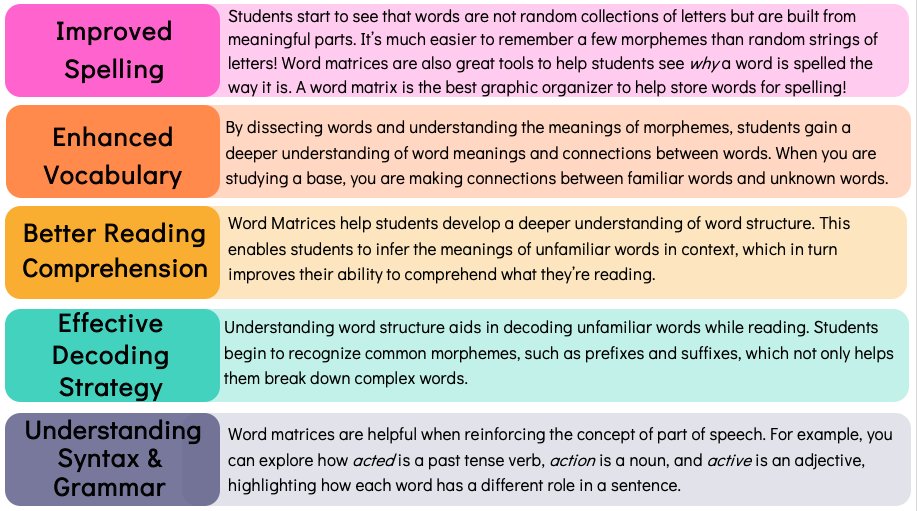
Honestly, since I started using word matrices, my spelling has improved!
How to Use a Completed Word Matrix with Students
When working with a fully completed matrix, the goal is to help students explore and understand the words it represents. Here’s a step-by-step approach:
- Introduce the Base Element: Begin by discussing the base and its meaning.
- Review Prefixes and Suffixes: Go over each prefix and suffix in the matrix, explaining their meanings.
- Model Combining Parts: Show students how to combine prefixes, the base, and suffixes to form words. Write a few examples together.
- Write Word Sums: To show how morphemes go together to make words, write a word sum.
- Explore Word Meanings: Discuss how adding different prefixes or suffixes changes the meaning of the base word.
- Practice Reading and Writing Words: Have students practice decoding and spelling words using the morphemes in the matrix.
How to Build a Word Matrix with Students
Building a word matrix is engaging and collaborative! Here’s how to do it:
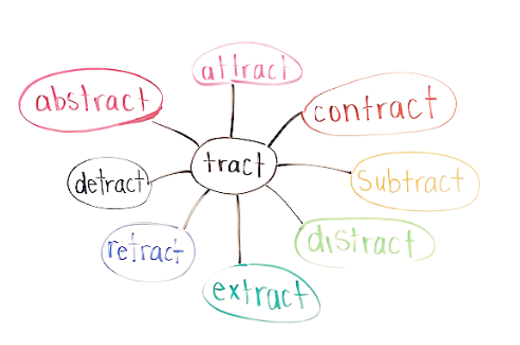
- Choose a Base Element: Select a base that’s appropriate for your students’ level. For younger students, pick simple free bases like help or play. For older students, use more complex bound bases like struct or spect.
- Brainstorm Known Words: Ask students to think of words they know that contain the base. Write these words on the board as a list or a word web. Then, add additional words of your own (that your students may not think of).
- Identify Morphemes: Break the words into their meaningful parts (prefix, base, and suffix). It helps to underline the base in each word and ask your students what prefixes or suffixes they see. Write a word sum of the word. For example, if your students brainstormed the word “subject”, you would write this word sum: sub+ject→subject.
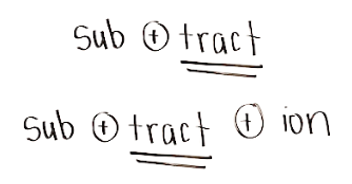
- Create the Matrix: Draw a grid on the board or use a printed template. Write the base in the middle. Look through your list of words. Use the word sums to help you take the morphemes from the word and place them in the matrix. For example, to add “subject” into the matrix you would write “sub” in the prefix column. Optional: Discuss the meanings of each part as you build it.
- Fill in the Blanks: Work together to fill in the matrix with all possible combinations. Add any new prefixes or suffixes. For example, once you have subject, you can add suffixes -ive, -ed, -ing, -s to the matrix.
- Test combinations: Ask, “Does in- + ject + -ed work? What about pro- + ject + -or?”
- Refine: Cross out combinations that don’t form real words and discuss why.

Sometimes, I skip the step where I write out the words first. Instead, I’ll put the base in the middle and suggest different prefixes and suffixes, asking my students if they think it would make a word. You can use guiding questions to assist your students with brainstorming words.
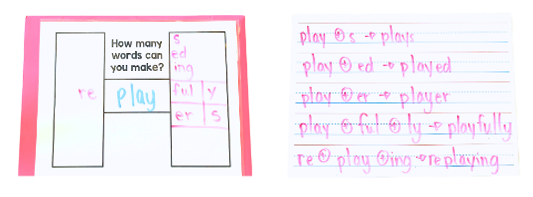
With this matrix, I started with the free base “play”. I used it in a sentence. Then, I said, What suffix do we use to spell “plays”? How about “played”? Once they answered I wrote those suffixes in the suffix column. Then I may say, What is the word for someone who plays on a team? Once they figure out the wrod is “player”, I tell them the suffix or ask if they know what it is (depending on if I’ve taught it yet). I continue with these guiding questions to complete the matrix. Then, we write word sums and spell the words out.
It is helpful to have a morpheme chart to keep track of the prefixes and suffixes you’ve used (as well as the bases you’ve created matrices for.
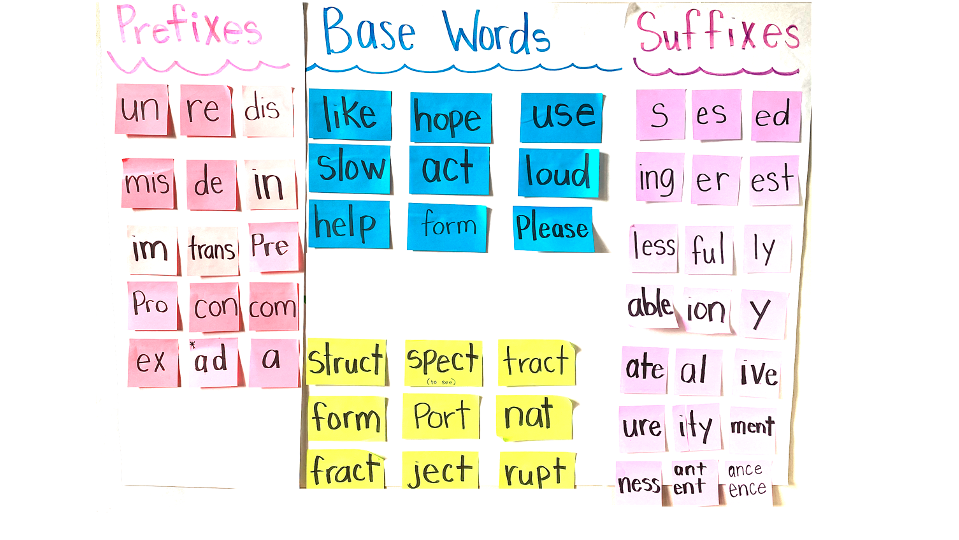
Once you’ve made several matrices with your students, you can also have them explore a little more while building a matrix. I do this with pre-made morpheme cards.
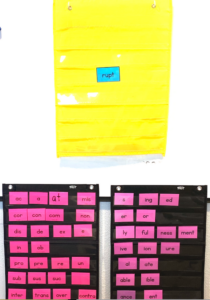
I got into the habit of having my pre-made prefix and suffix cards displayed in small pocket charts. This way, they were readily available. In this example here, we are about to build a matrix for the bound base <rupt>. I placed that base in teh center of my pocket chart.
Next, we brainstormed words with <rupt>. Students used the prefixes and suffixes we had displayed to help them find words. Of course with this method, you get a lot of nonwords like “conrupt”, but I think that’s okay! We were able to talk it out together. You could say, I don’t think that is a word, but wouldn’t it be an interesting word! If con means “together” and “rupt” means to burst, what could “conrupt” mean? I’m constantly telling my students that I wish I could make up words. I use the nonsense word “rememberful” all the time! This is a fun and memorable way to build a matrix. (Side note: I also keep a list of real words handy so I can guide as needed.)
Check out these YouTube videos showing how to create a word matrix.
- Creating a word matrix for <form>.
- Creating a word matrix for <help>
- More advanced video for matrix <rect>.
- Watch this Instagram reel exploring the base <rain>.
Displaying a Word Matrix
There are different methods for creating and using matrices. For example, you can write it on a blank template, use a digital option, create it with sticky notes (each representing a morpheme), or set it up in a pocket chart with pre-made morpheme cards. (Click here for pre-made morpheme cards for bases with Latin roots.)
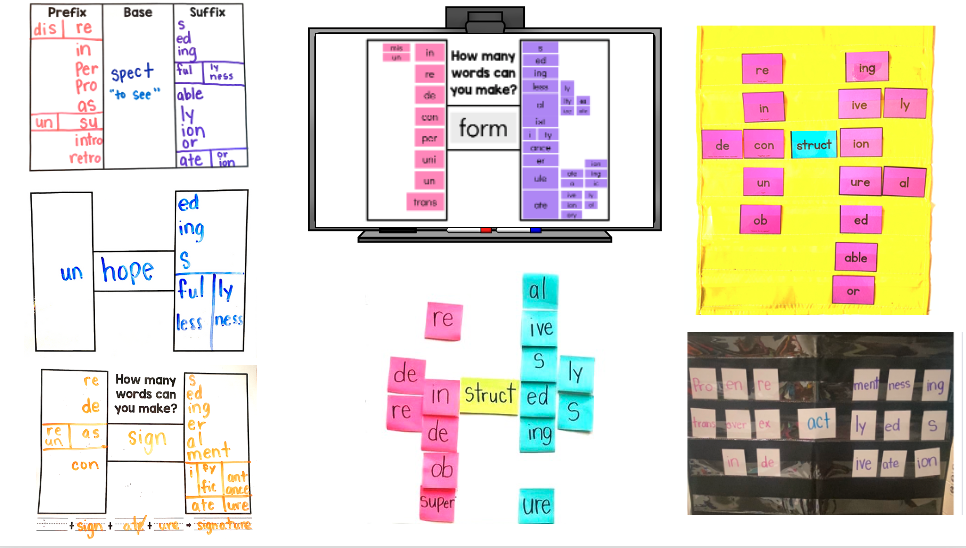
- Click here to grab a free template so you can make your own matrices.
- Click here to check out my resource with pre-made digital and printable word matrices.
- Click here to get pre-made morpheme cards (Latin roots).
Matrix Maker
Another way to make a matrix is with Neil Ramsden’s Matrix-Maker.
- Visit: https://www.neilramsden.co.uk/spelling/matrix/
- Write the base and the meaning (denotation)
- Write a word sum for each word. (Capitalize the base.)
- It will create a word matrix like the one shown below.
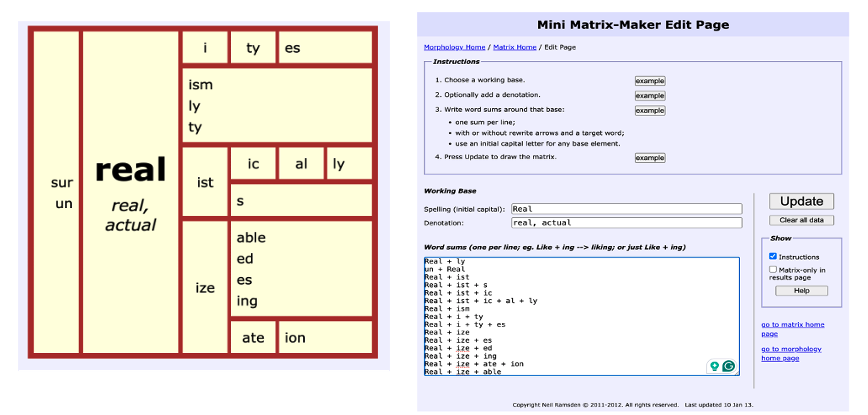
Activities
Word matrices are incredibly versatile and can be used in various activities to reinforce learning. Here are a few ideas:
Word Hunt: Once students have worked on a few matrices, you can give them a fully completed matrix and challenge them to figure out how many real words they can build from it. This activity reinforces their understanding of how prefixes and suffixes combine with the base word and helps them recognize patterns in word formation.
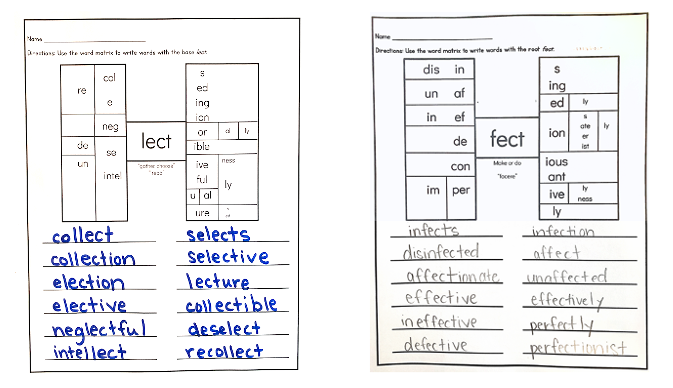
For a free blank version of the page above, click here. (The actual pages above can be found here.)
Build your Own Matrix: You can also flip the activity: provide students with a list of related words and have them build a matrix. With the example below, there are word with the base <port>. Once students have had enough practice, they can build a matrix. (Free Blank matrix found here.)
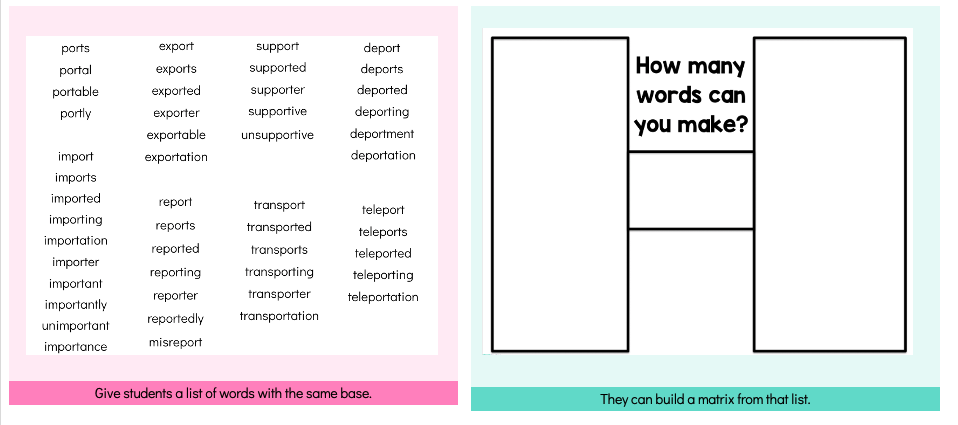
Sort Words by Prefix: For matrices with multiple prefixes, have students sort words by their prefixes to discover patterns. Observe how the base stays the same while prefixes and suffixes expand its use and meaning. This activity highlights the flexibility of word-building and the richness of English morphology. For a blank version of the word sort page shown below, click here.
Word Sums: Have students write word sums for each word they create. For example, retraction becomes re- + tract + -ion = retraction.
Guess my Word: Display a completed matrix. Give clues about a word. Have students study the matrix to combine morphemes so they guess the correct word.
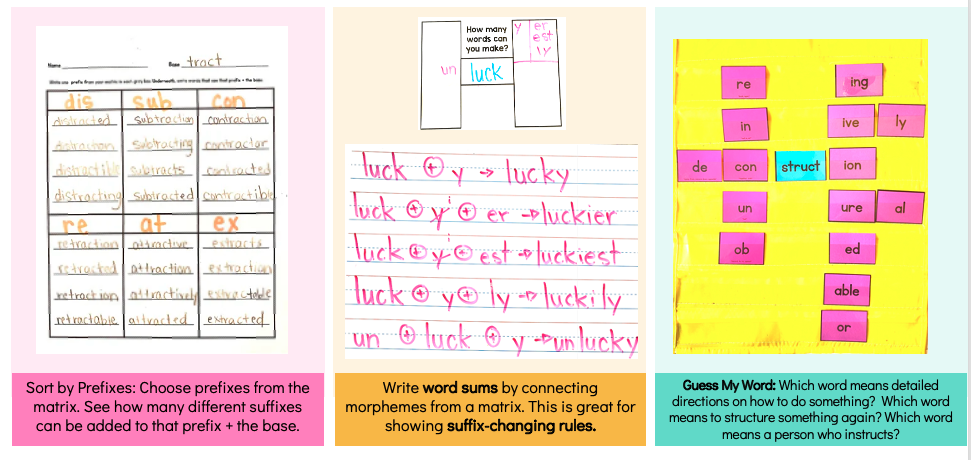
Hunt and Spell: Use a finished matrix. Say a word that can be created by combining morphemes. Have students hunt for the word on the matrix. Once they think they have found the morphemes that make that word, they will write it on their white boards. If there are suffix changes rules, they can also write a word sum. Watch this Instagram post to learn more.
Sentence Creation: Have students use words from the matrix in sentences. This helps them connect the words to real-life contexts.
Morphological Puzzles: Write incomplete word sums on the board and challenge students to fill in the missing parts.
Guess the meaning: Define one of the prefixes. Then, ask students to define a word with that prefix. For example, if re- means back or again, what could “retract” mean”?
Explore How Suffixes and Prefixes Work Differently: Use the matrix to show how suffixes often change the part of speech (e.g., turning inject into injection to create a noun or injecting to create a verb), while prefixes shift the meaning of the word (e.g., inject means “to throw in,” but reject means “to throw back”). Discuss these differences as students create words, emphasizing how affixes work together to form both meaning and grammatical structure. Check this reel to see how I did this with the base <rain>.
The Role of Word Sums
Word sums are a key part of working with word matrices and understanding how words are constructed. A word sum is a way to break a word into its meaningful parts—its base, prefixes, and suffixes—showing how those elements combine to create the full word.
Word sums can also help bridge the gap between the matrix and the actual spelling of words. They highlight suffix changing rules. (Check this post to learn about suffix changing rules.)
- For example, a matrix might show the base hope and the suffix -ing, but writing the word sum (hope + ing –> hoping) helps students see why the silent e is dropped.
- Similarly, word sums show that doubling happens in hopped (hop + p + ed –> hopped).
- With suffixes like -y, you can show the changing rule where y changes to i like in “healthier” or “luckily”. (See the word sum of “lucky” above with the word sums.)
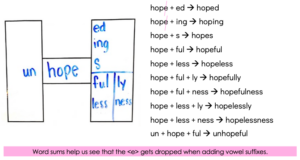
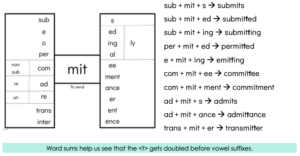
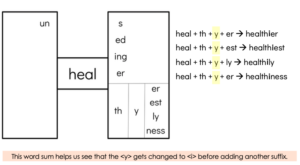
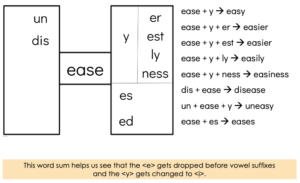
This practice helps students internalize spelling patterns and suffix-changing rules.
Highlighting Pronunciation Shifts with Word Matrices
Word matrices are also powerful tools for exploring pronunciation shifts that occur when morphemes combine. As students build and analyze words from a matrix, they can observe how the pronunciation of a base or affix may change, even though the spelling and meaning remain connected. These shifts can help students understand the deeper structure of words and how language evolves.
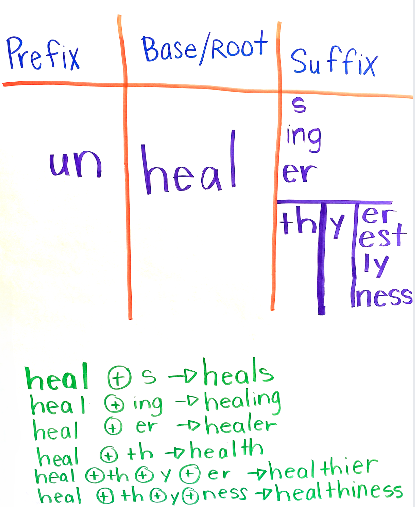
For example, take the base “heal.“ In “heal,” “heals,” “healed,” “healing,” and “healer,” the <ea> make the long e sound. When you add the suffix -th to make “health,” it shifts to a short e sound. (Also healthy, healthier, healthiest, healthily, healthiness use the short e sound.) It still retains its core meaning and spelling, though.
Similarly, the base “please” changes pronunciation in “pleasure” and “pleasant”. The <ea> shifts to short e. Additionally, the <s> in “pleasure” also shifts to a /zh/ sound. All these words relate to the concept of pleasing or satisfaction.
By studying matrices, students can see these connections and begin to expect that such shifts are part of the natural structure of English.
Look at all the pronunciation shifts with the words below!
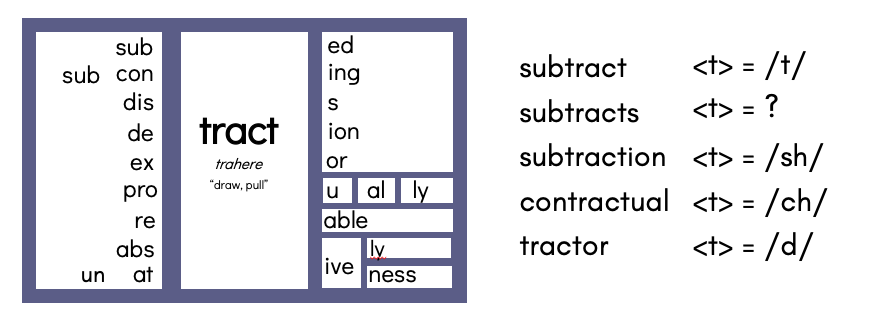
This exploration can also help students decode words more effectively, as they’ll learn to identify roots and affixes even when they sound different. Additionally, it reinforces the idea that English spelling is tied to both meaning and history, which helps make sense of seemingly irregular words. Exploring pronunciation shifts through word matrices gives students a deeper appreciation for the richness and logic of the language.
Resources
Looking for pre-made word matrices? I’ve got you covered! This resource has tons of digital and printable matrices with bases from Latin roots.
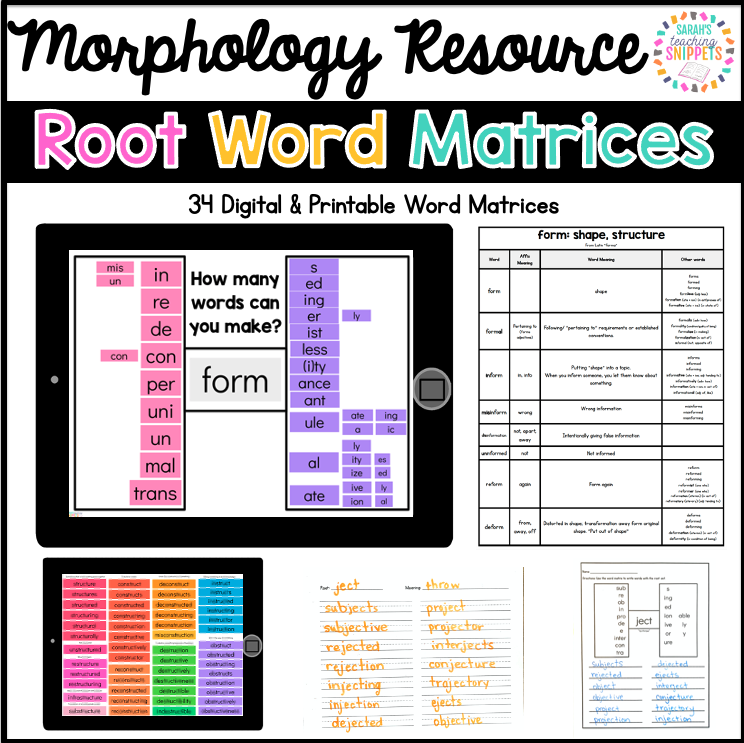
Word matrices are a powerful tool for helping students unlock the structure and meaning of words. By teaching students how to read and build matrices, you’re giving them a lifelong strategy for understanding vocabulary. Plus, the process is engaging and fun, turning word study into an exciting discovery process. Whether you’re using a pre-made matrix or building one from scratch, your students will love exploring the connections between words and growing their understanding of language.
Next Post… Structured Word Inquiry
Can you believe that you can take all this one step further?! You can tie in etymology and investigation with Structured Word Inquiry. I will write a blog post about that next. In the meantime, visit Pete Bowers’ website to learn all about it!









